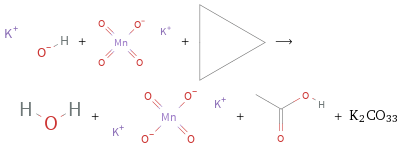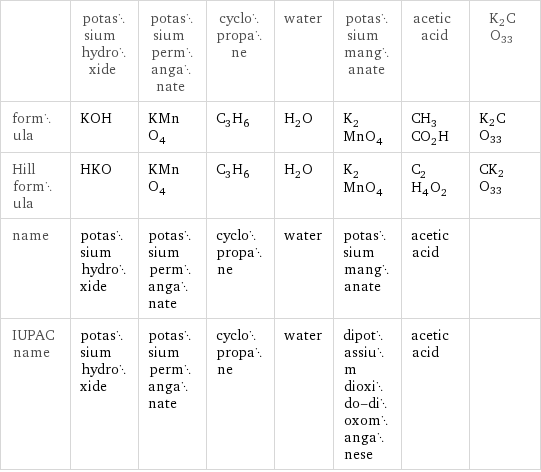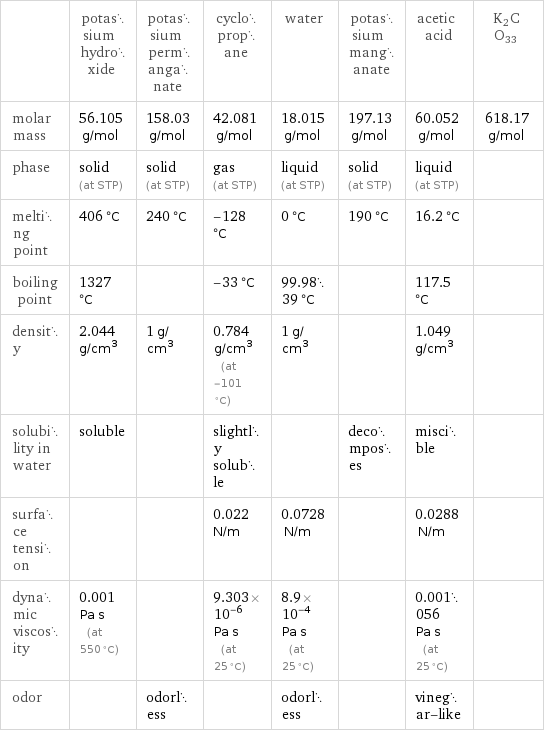Input interpretation

KOH potassium hydroxide + KMnO_4 potassium permanganate + C_3H_6 cyclopropane ⟶ H_2O water + K_2MnO_4 potassium manganate + CH_3CO_2H acetic acid + K2CO33
Balanced equation

Balance the chemical equation algebraically: KOH + KMnO_4 + C_3H_6 ⟶ H_2O + K_2MnO_4 + CH_3CO_2H + K2CO33 Add stoichiometric coefficients, c_i, to the reactants and products: c_1 KOH + c_2 KMnO_4 + c_3 C_3H_6 ⟶ c_4 H_2O + c_5 K_2MnO_4 + c_6 CH_3CO_2H + c_7 K2CO33 Set the number of atoms in the reactants equal to the number of atoms in the products for H, K, O, Mn and C: H: | c_1 + 6 c_3 = 2 c_4 + 4 c_6 K: | c_1 + c_2 = 2 c_5 + 2 c_7 O: | c_1 + 4 c_2 = c_4 + 4 c_5 + 2 c_6 + 33 c_7 Mn: | c_2 = c_5 C: | 3 c_3 = 2 c_6 + c_7 Since the coefficients are relative quantities and underdetermined, choose a coefficient to set arbitrarily. To keep the coefficients small, the arbitrary value is ordinarily one. For instance, set c_3 = 1 and solve the system of equations for the remaining coefficients: c_2 = (32 c_1)/33 + 2/11 c_3 = 1 c_4 = (17 c_1)/33 - 1/11 c_5 = (32 c_1)/33 + 2/11 c_6 = 17/11 - c_1/132 c_7 = c_1/66 - 1/11 The resulting system of equations is still underdetermined, so an additional coefficient must be set arbitrarily. Set c_1 = 72 and solve for the remaining coefficients: c_1 = 72 c_2 = 70 c_3 = 1 c_4 = 37 c_5 = 70 c_6 = 1 c_7 = 1 Substitute the coefficients into the chemical reaction to obtain the balanced equation: Answer: | | 72 KOH + 70 KMnO_4 + C_3H_6 ⟶ 37 H_2O + 70 K_2MnO_4 + CH_3CO_2H + K2CO33
Structures

+ + ⟶ + + + K2CO33
Names

potassium hydroxide + potassium permanganate + cyclopropane ⟶ water + potassium manganate + acetic acid + K2CO33
Equilibrium constant
![Construct the equilibrium constant, K, expression for: KOH + KMnO_4 + C_3H_6 ⟶ H_2O + K_2MnO_4 + CH_3CO_2H + K2CO33 Plan: • Balance the chemical equation. • Determine the stoichiometric numbers. • Assemble the activity expression for each chemical species. • Use the activity expressions to build the equilibrium constant expression. Write the balanced chemical equation: 72 KOH + 70 KMnO_4 + C_3H_6 ⟶ 37 H_2O + 70 K_2MnO_4 + CH_3CO_2H + K2CO33 Assign stoichiometric numbers, ν_i, using the stoichiometric coefficients, c_i, from the balanced chemical equation in the following manner: ν_i = -c_i for reactants and ν_i = c_i for products: chemical species | c_i | ν_i KOH | 72 | -72 KMnO_4 | 70 | -70 C_3H_6 | 1 | -1 H_2O | 37 | 37 K_2MnO_4 | 70 | 70 CH_3CO_2H | 1 | 1 K2CO33 | 1 | 1 Assemble the activity expressions accounting for the state of matter and ν_i: chemical species | c_i | ν_i | activity expression KOH | 72 | -72 | ([KOH])^(-72) KMnO_4 | 70 | -70 | ([KMnO4])^(-70) C_3H_6 | 1 | -1 | ([C3H6])^(-1) H_2O | 37 | 37 | ([H2O])^37 K_2MnO_4 | 70 | 70 | ([K2MnO4])^70 CH_3CO_2H | 1 | 1 | [CH3CO2H] K2CO33 | 1 | 1 | [K2CO33] The equilibrium constant symbol in the concentration basis is: K_c Mulitply the activity expressions to arrive at the K_c expression: Answer: | | K_c = ([KOH])^(-72) ([KMnO4])^(-70) ([C3H6])^(-1) ([H2O])^37 ([K2MnO4])^70 [CH3CO2H] [K2CO33] = (([H2O])^37 ([K2MnO4])^70 [CH3CO2H] [K2CO33])/(([KOH])^72 ([KMnO4])^70 [C3H6])](../image_source/c70fa3a4f28bd18bad42013ce10043c9.png)
Construct the equilibrium constant, K, expression for: KOH + KMnO_4 + C_3H_6 ⟶ H_2O + K_2MnO_4 + CH_3CO_2H + K2CO33 Plan: • Balance the chemical equation. • Determine the stoichiometric numbers. • Assemble the activity expression for each chemical species. • Use the activity expressions to build the equilibrium constant expression. Write the balanced chemical equation: 72 KOH + 70 KMnO_4 + C_3H_6 ⟶ 37 H_2O + 70 K_2MnO_4 + CH_3CO_2H + K2CO33 Assign stoichiometric numbers, ν_i, using the stoichiometric coefficients, c_i, from the balanced chemical equation in the following manner: ν_i = -c_i for reactants and ν_i = c_i for products: chemical species | c_i | ν_i KOH | 72 | -72 KMnO_4 | 70 | -70 C_3H_6 | 1 | -1 H_2O | 37 | 37 K_2MnO_4 | 70 | 70 CH_3CO_2H | 1 | 1 K2CO33 | 1 | 1 Assemble the activity expressions accounting for the state of matter and ν_i: chemical species | c_i | ν_i | activity expression KOH | 72 | -72 | ([KOH])^(-72) KMnO_4 | 70 | -70 | ([KMnO4])^(-70) C_3H_6 | 1 | -1 | ([C3H6])^(-1) H_2O | 37 | 37 | ([H2O])^37 K_2MnO_4 | 70 | 70 | ([K2MnO4])^70 CH_3CO_2H | 1 | 1 | [CH3CO2H] K2CO33 | 1 | 1 | [K2CO33] The equilibrium constant symbol in the concentration basis is: K_c Mulitply the activity expressions to arrive at the K_c expression: Answer: | | K_c = ([KOH])^(-72) ([KMnO4])^(-70) ([C3H6])^(-1) ([H2O])^37 ([K2MnO4])^70 [CH3CO2H] [K2CO33] = (([H2O])^37 ([K2MnO4])^70 [CH3CO2H] [K2CO33])/(([KOH])^72 ([KMnO4])^70 [C3H6])
Rate of reaction
![Construct the rate of reaction expression for: KOH + KMnO_4 + C_3H_6 ⟶ H_2O + K_2MnO_4 + CH_3CO_2H + K2CO33 Plan: • Balance the chemical equation. • Determine the stoichiometric numbers. • Assemble the rate term for each chemical species. • Write the rate of reaction expression. Write the balanced chemical equation: 72 KOH + 70 KMnO_4 + C_3H_6 ⟶ 37 H_2O + 70 K_2MnO_4 + CH_3CO_2H + K2CO33 Assign stoichiometric numbers, ν_i, using the stoichiometric coefficients, c_i, from the balanced chemical equation in the following manner: ν_i = -c_i for reactants and ν_i = c_i for products: chemical species | c_i | ν_i KOH | 72 | -72 KMnO_4 | 70 | -70 C_3H_6 | 1 | -1 H_2O | 37 | 37 K_2MnO_4 | 70 | 70 CH_3CO_2H | 1 | 1 K2CO33 | 1 | 1 The rate term for each chemical species, B_i, is 1/ν_i(Δ[B_i])/(Δt) where [B_i] is the amount concentration and t is time: chemical species | c_i | ν_i | rate term KOH | 72 | -72 | -1/72 (Δ[KOH])/(Δt) KMnO_4 | 70 | -70 | -1/70 (Δ[KMnO4])/(Δt) C_3H_6 | 1 | -1 | -(Δ[C3H6])/(Δt) H_2O | 37 | 37 | 1/37 (Δ[H2O])/(Δt) K_2MnO_4 | 70 | 70 | 1/70 (Δ[K2MnO4])/(Δt) CH_3CO_2H | 1 | 1 | (Δ[CH3CO2H])/(Δt) K2CO33 | 1 | 1 | (Δ[K2CO33])/(Δt) (for infinitesimal rate of change, replace Δ with d) Set the rate terms equal to each other to arrive at the rate expression: Answer: | | rate = -1/72 (Δ[KOH])/(Δt) = -1/70 (Δ[KMnO4])/(Δt) = -(Δ[C3H6])/(Δt) = 1/37 (Δ[H2O])/(Δt) = 1/70 (Δ[K2MnO4])/(Δt) = (Δ[CH3CO2H])/(Δt) = (Δ[K2CO33])/(Δt) (assuming constant volume and no accumulation of intermediates or side products)](../image_source/240c7102ce6920980fe88b9333b49d3d.png)
Construct the rate of reaction expression for: KOH + KMnO_4 + C_3H_6 ⟶ H_2O + K_2MnO_4 + CH_3CO_2H + K2CO33 Plan: • Balance the chemical equation. • Determine the stoichiometric numbers. • Assemble the rate term for each chemical species. • Write the rate of reaction expression. Write the balanced chemical equation: 72 KOH + 70 KMnO_4 + C_3H_6 ⟶ 37 H_2O + 70 K_2MnO_4 + CH_3CO_2H + K2CO33 Assign stoichiometric numbers, ν_i, using the stoichiometric coefficients, c_i, from the balanced chemical equation in the following manner: ν_i = -c_i for reactants and ν_i = c_i for products: chemical species | c_i | ν_i KOH | 72 | -72 KMnO_4 | 70 | -70 C_3H_6 | 1 | -1 H_2O | 37 | 37 K_2MnO_4 | 70 | 70 CH_3CO_2H | 1 | 1 K2CO33 | 1 | 1 The rate term for each chemical species, B_i, is 1/ν_i(Δ[B_i])/(Δt) where [B_i] is the amount concentration and t is time: chemical species | c_i | ν_i | rate term KOH | 72 | -72 | -1/72 (Δ[KOH])/(Δt) KMnO_4 | 70 | -70 | -1/70 (Δ[KMnO4])/(Δt) C_3H_6 | 1 | -1 | -(Δ[C3H6])/(Δt) H_2O | 37 | 37 | 1/37 (Δ[H2O])/(Δt) K_2MnO_4 | 70 | 70 | 1/70 (Δ[K2MnO4])/(Δt) CH_3CO_2H | 1 | 1 | (Δ[CH3CO2H])/(Δt) K2CO33 | 1 | 1 | (Δ[K2CO33])/(Δt) (for infinitesimal rate of change, replace Δ with d) Set the rate terms equal to each other to arrive at the rate expression: Answer: | | rate = -1/72 (Δ[KOH])/(Δt) = -1/70 (Δ[KMnO4])/(Δt) = -(Δ[C3H6])/(Δt) = 1/37 (Δ[H2O])/(Δt) = 1/70 (Δ[K2MnO4])/(Δt) = (Δ[CH3CO2H])/(Δt) = (Δ[K2CO33])/(Δt) (assuming constant volume and no accumulation of intermediates or side products)
Chemical names and formulas

| potassium hydroxide | potassium permanganate | cyclopropane | water | potassium manganate | acetic acid | K2CO33 formula | KOH | KMnO_4 | C_3H_6 | H_2O | K_2MnO_4 | CH_3CO_2H | K2CO33 Hill formula | HKO | KMnO_4 | C_3H_6 | H_2O | K_2MnO_4 | C_2H_4O_2 | CK2O33 name | potassium hydroxide | potassium permanganate | cyclopropane | water | potassium manganate | acetic acid | IUPAC name | potassium hydroxide | potassium permanganate | cyclopropane | water | dipotassium dioxido-dioxomanganese | acetic acid |
Substance properties

| potassium hydroxide | potassium permanganate | cyclopropane | water | potassium manganate | acetic acid | K2CO33 molar mass | 56.105 g/mol | 158.03 g/mol | 42.081 g/mol | 18.015 g/mol | 197.13 g/mol | 60.052 g/mol | 618.17 g/mol phase | solid (at STP) | solid (at STP) | gas (at STP) | liquid (at STP) | solid (at STP) | liquid (at STP) | melting point | 406 °C | 240 °C | -128 °C | 0 °C | 190 °C | 16.2 °C | boiling point | 1327 °C | | -33 °C | 99.9839 °C | | 117.5 °C | density | 2.044 g/cm^3 | 1 g/cm^3 | 0.784 g/cm^3 (at -101 °C) | 1 g/cm^3 | | 1.049 g/cm^3 | solubility in water | soluble | | slightly soluble | | decomposes | miscible | surface tension | | | 0.022 N/m | 0.0728 N/m | | 0.0288 N/m | dynamic viscosity | 0.001 Pa s (at 550 °C) | | 9.303×10^-6 Pa s (at 25 °C) | 8.9×10^-4 Pa s (at 25 °C) | | 0.001056 Pa s (at 25 °C) | odor | | odorless | | odorless | | vinegar-like |
Units
